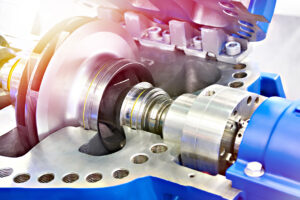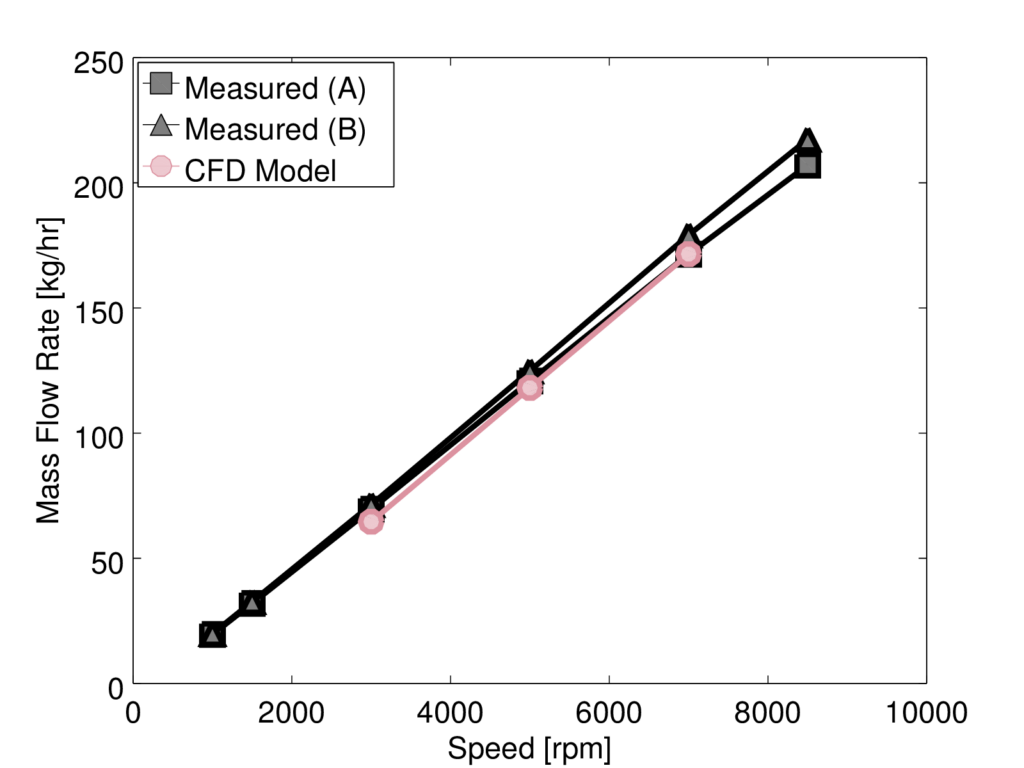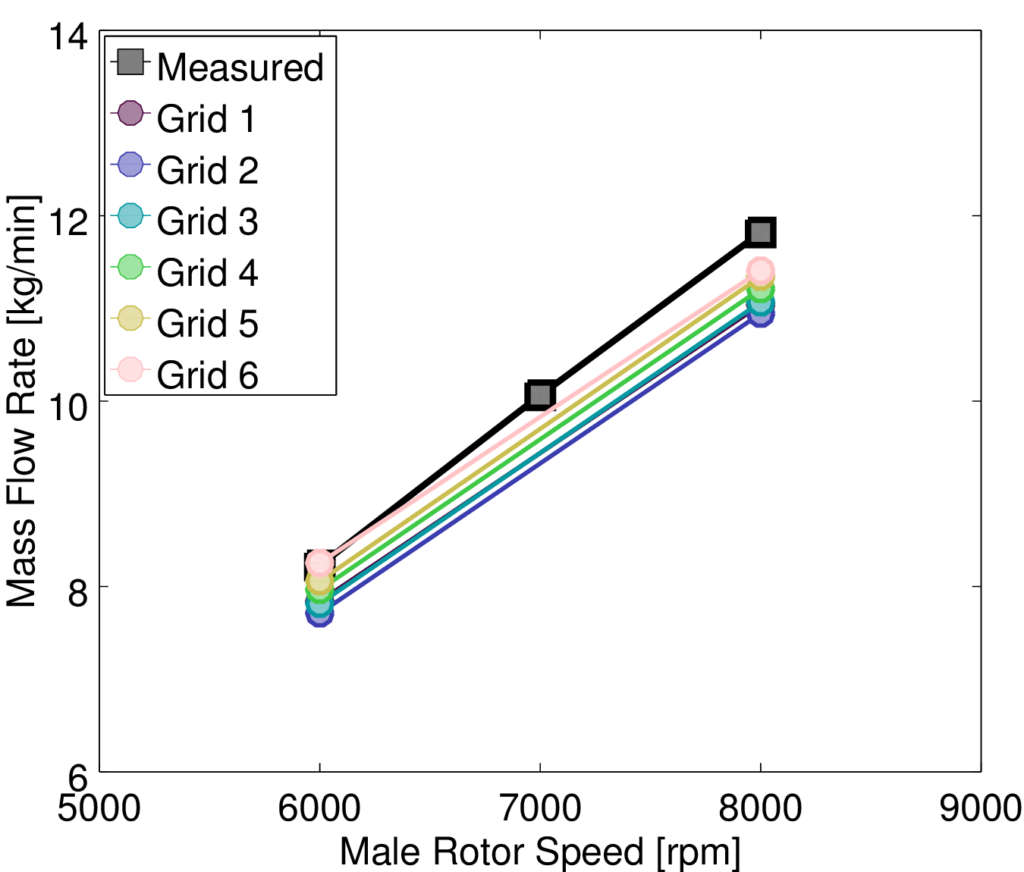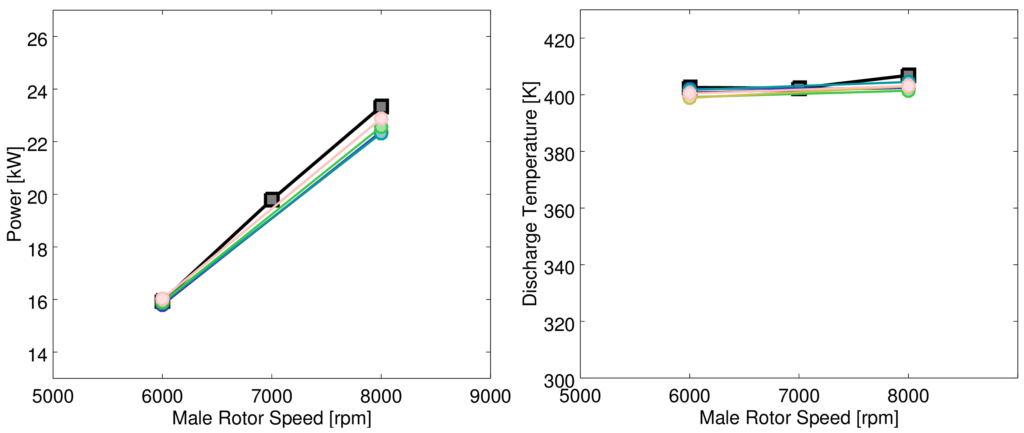
Author:
Elizabeth Favreau
Marketing Writing Team Lead
Across industries, manufacturers share many of the same goals: create quality products, boost productivity, and reduce expenses. In the pumps and compressors business, manufacturers must contend with the complexity of the machines themselves in order to reach these goals. Given the intricate geometries, moving components, and tight clearances between parts, designing pumps and compressors to be efficient and reliable is no trivial matter.
First, assessing the device’s performance by building and testing a prototype can be time-consuming and costly. And when you’re performing a design study, machining and switching out various components further compounds your expenses. There are also limitations in how many instruments you can place inside the device and where you can place them, which can make fully characterizing the machine difficult. New methods for testing and manufacturing can help streamline this process, but there remains room for alternative approaches.

Computational fluid dynamics (CFD) offers significant advantages for designing pumps and compressors. Through CFD simulations, you can obtain valuable insight into the behavior of the fluid inside your machine and the interactions between the fluid and solid components—and CONVERGE CFD software is well suited for the task.
Designed to model three-dimensional fluid flows in systems with complex geometries and moving boundaries, CONVERGE is equipped to simulate any positive displacement or dynamic pump or compressor. And with a suite of advanced models, CONVERGE allows you to computationally study the physical phenomena that affect efficiency and reliability—such as surge, pressure pulsations, cavitation, and vibration—to design an optimal machine.
CFD provides a unique opportunity to visualize the inner workings of your machine during operation, generating data on pressures, temperatures, velocities, and fluid properties without the limitations of physical measurements. The entire flow field can be analyzed with CFD, including areas that are difficult or impossible to measure experimentally. This additional data allows you to comprehensively characterize your pump or compressor and pinpoint areas for improvement.
Since CONVERGE leads the way in predictive CFD technology, you can analyze pump and compressor designs that have not yet been built and still be confident in your results. Compared to building and testing prototypes, simulations are fast and inexpensive, and altering a computer-modeled geometry is trivial. Iterating through designs virtually and building only the most promising candidates reduces the expenses associated with the design process.
While three-dimensional CFD is fast compared to experimental methods, it is typically slower than one- or two-dimensional analysis tools, which are often incorporated into the design process. However, 1D and 2D methods are inherently limited in their ability to capture the 3D nature of physical flows, and thus can miss important flow phenomena that may negatively affect performance.
CONVERGE drastically reduces the time required to set up a 3D pump or compressor simulation with its autonomous meshing capabilities. Creating a mesh by hand—which is standard practice in many CFD programs—can be a weeks-long process, particularly for cases with complex moving geometries such as pumps and compressors. With autonomous meshing, CONVERGE automatically generates an optimized Cartesian mesh based on a few simple user-defined parameters, effectively eliminating all user meshing time.
In addition, the increased computational resources available today can greatly reduce the time requirements to run CFD simulations. CONVERGE is specifically designed to enable highly parallel simulations to run on many processors and demonstrates excellent scaling on thousands of cores. Additionally, Convergent Science partners with cloud service providers, who offer affordable on-demand access to the latest computing resources, making it simple to speed up your simulations.
Accurately capturing real-world physical phenomena is critical to obtaining useful simulation results. CONVERGE features robust fluid-structure interaction (FSI) modeling capabilities. For example, you can simulate the interaction between the bulk flow and the valves to predict impact velocity, fatigue, and failure points. CONVERGE also features a conjugate heat transfer (CHT) model to resolve spatially varying surface temperature distributions, and a multi-phase model to study cavitation, oil splashing, and other free surface flows of interest.
CONVERGE has been validated on numerous types of compressors and pumps1-10, and we will discuss two common applications below.
Scroll compressors are often used in air conditioning systems, and the major design goals for these machines today are reducing noise and improving efficiency. Scroll compressors consist of a stationary scroll and an orbiting scroll, which create a complex system that can be challenging to model. Some codes use a moving mesh to simulate moving boundaries, but this can introduce diffusive error that lowers the accuracy of your results. CONVERGE automatically generates a stationary mesh at each time-step to accommodate moving boundaries, which provides high numerical accuracy. In addition, CONVERGE employs a unique Cartesian cut-cell approach to perfectly represent your compressor geometry, no matter how complex.
In this study1, CONVERGE was used to simulate a scroll compressor with a deforming reed valve. An FSI model was used to capture the motion of the discharge reed valve. Figure 1 shows the CFD-predicted mass flow rate through the scroll compressor compared to experimental values. As you can see, there is good agreement between the simulation and experiment.
This method is particularly useful for the optimization phase of design, as parametric changes to the geometry can be easily incorporated. In addition, Adaptive Mesh Refinement (AMR) allows you to accurately capture the physical phenomena of interest while maintaining a reasonable computational expense.


Next, we will look at a twin screw compressor. These compressors have two helical screws that rotate in opposite directions, and are frequently used in industrial, manufacturing, and refrigeration applications. A common challenge for designing screw compressors—and many other pumps and compressors—is the tight clearances between parts. Inevitably, there will be some leakage flow between chambers, which will affect the device’s performance.
CONVERGE offers several methods for capturing the fluid behavior in these small gaps. Using local mesh embedding and AMR, you can directly resolve the gaps. This method is highly accurate, but it can come with a high computational price tag. An alternative approach is to use one of CONVERGE’s gap models to account for the leakage flows without fully resolving the gaps. This method balances accuracy and time costs, so you can get the results you need when you need them.
Another factor that must be taken into account when designing screw compressors is thermal expansion. Heat transfer between the fluid and the solid walls means the clearances will vary down the length of the rotors. CONVERGE’s CHT model can capture the heat transfer between the solid and the fluid to account for this phenomenon.
This study2 of a dry twin screw compressor employs a gap model to account for leakage flows, CHT modeling to capture heat transfer, and AMR to resolve large-scale flow structures. Mass flow rate, power, and discharge temperature were predicted with CONVERGE and compared to experimentally measured values. This study also investigated the effects of the base grid size on the accuracy of the results. In Figure 2, you can see there is good agreement between the experimental and simulated data, particularly for the most refined grid. The method used in this study provides accurate results in a turn-around time that is practical for engineering applications.



The benefits CONVERGE offers for designing pumps and compressors directly translate to a tangible competitive advantage. CFD benefits your business by reducing costs and enabling you to bring your product to market faster, and CONVERGE features tools to help you optimize your designs and produce high-quality products for your customers. To find out how CONVERGE can benefit you, contact us today!
[1] Rowinski, D., Pham, H.-D., and Brandt, T., “Modeling a Scroll Compressor Using a Cartesian Cut-Cell Based CFD Methodology with Automatic Adaptive Meshing,” 24th International Compressor Engineering Conference at Purdue, 1252, West Lafayette, IN, United States, Jul 9–12, 2018.
[2] Rowinski, D., Li, Y., and Bansal, K., “Investigations of Automatic Meshing in Modeling a Dry Twin Screw Compressor,” 24th International Compressor Engineering Conference at Purdue, 1528, West Lafayette, IN, United States, Jul 9–12, 2018.
[3] Rowinski, D., Sadique, J., Oliveira, S., and Real, M., “Modeling a Reciprocating Compressor Using a Two-Way Coupled Fluid and Solid Solver with Automatic Grid Generation and Adaptive Mesh Refinement,” 24th International Compressor Engineering Conference at Purdue, 1587, West Lafayette, IN, United States, Jul 9–12, 2018.
[4] Rowinski, D.H., Nikolov, A., and Brümmer, A., “Modeling a Dry Running Twin-Screw Expander using a Coupled Thermal-Fluid Solver with Automatic Mesh Generation,” 10th International Conference on Screw Machines, Dortmund, Germany, Sep 18–19, 2018.
[5] da Silva, L.R., Dutra, T., Deschamps, C.J., and Rodrigues, T.T., “A New Modeling Strategy to Simulation the Compression Cycle of Reciprocating Compressors,” IIR Conference on Compressors, 0226, Bratislava, Slovakia, Sep 6–8, 2017. DOI: 10.18462/iir.compr.2017.0226
[6] Willie, J., “Analytical and Numerical Prediction of the Flow and Performance in a Claw Vacuum Pump,” 10th International Conference on Screw Machines, Dortmund, Germany, Sep 18–19, 2018. DOI: 10.1088/1757-899X/425/1/012026
[7] Jhun, C., Siedlecki, C., Xu, L., Lukic, B., Newswanger, R., Yeager, E., Reibson, J., Cysyk, J., Weiss, W., and Rosenberg, G., “Stress and Exposure Time on Von Willebrand Factor Degradation,” Artificial Organs, 2018. DOI: 10.1111/aor.13323
[8] Rowinski, D.H., “New Applications in Multi-Phase Flow Modeling With CONVERGE: Gerotor Pumps, Fuel Tank Sloshing, and Gear Churning,” 2018 CONVERGE User Conference–Europe, Bologna, Italy, Mar 19–23, 2018. https://cdn.convergecfd.com/David-Rowinski_Multiphase-Modeling-Gearbox-Power-Losses-Oil-Pump-Cavitation-and-Fuel-Tank-Sloshing.pdf
[9] Willie, J., “Simulation and Optimization of Flow Inside Claw Vacuum Pumps,” 2018 CONVERGE User Conference–Europe, Bologna, Italy, Mar 19–23, 2018. https://cdn.convergecfd.com/james-willie-simulation-and-optimization-of-flow-inside-claw-vacuum-pumps.pdf
[10] Scheib, C.M., Newswanger, R.K., Cysyk, J.P., Reibson, J.D., Lukic, B., Doxtater, B., Yeager, E., Leibich, P., Bletcher, K., Siedlecki, C.A., Weiss, W.J., Rosenberg, G., and Jhun, C., “LVAD Redesign: Pump Variation for Minimizing Thrombus Susceptibility Potential,” ASAIO 65th Annual Conference, San Francisco, CA, United States, Jun 26–29, 2019.


